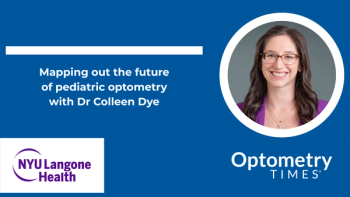
SightGlass to share new insights on DOT spectacle lenses during AAOpt Academy 2025
New interim data demonstrate that more than half of children wearing DOT lenses experienced no clinically meaningful myopia progression over 18 months.
Of children wearing Diffusion Optics Technology (DOT) spectacle lenses as part of a recent study, more than half experienced no clinically meaningful myopia progression, according to new 18-month data released by SightGlass Vision.1 These findings, in addition to more recent research from the company, will be presented at the American Academy of Optometry’s 2025 annual meeting in Boston, Massachusetts, running from October 8 to 11, according to a news release.
The number of patients who experienced no clinically significant myopia progression was almost 4 times the rate seen in children wearing standard single-vision spectacle lenses, the company stated.1
“We are presenting compelling research at Academy ’25 that reinforces the efficacy of DOT lenses,” said Andrew Sedgwick, CEO of SightGlass Vision, in the release. “Momentum continues to grow, with over one million children having worn DOT lenses, and we recently expanded into the UK through an early access launch. DOT is becoming a globally trusted solution for protecting children’s vision, and we are grateful for the opportunity to share new insights with our colleagues and to drive more progress in the urgent fight against childhood myopia.”
The interim data will be presented by Jennifer Hill on October 9 in her “Control of myopia using contrast modulation spectacle lenses in a Chinese population: 18-month results” presentation. These data were pulled from SightGlass’s ongoing study that includes patients in 5 Chinese hospitals and builds on previous 12-month results that found that DOT 0.2 can slow average myopia progression by up to 75% after 12 months of wear across diverse populations.1
Specifically, the new 18-month data demonstrated a majority of children (57%) that wore DOT lenses had no clinically significant myopia progression in comparison to 15% of patients in the control group.1 “These results also show significant effects on axial length elongation and cycloplegic spherical equivalent refraction progression, with DOT lens wearers exhibiting 0.34 mm and 0.70 D less than the control group, respectively,” the release stated.
Other data from SightGlass at the Academy meeting will be presented by Debbie Laughton, BSc, PhD, who will be providing insights into the relationship between DOT lenses and astigmatism. The 12-month data comes from a North American study and Chinese study that demonstrated that DOT lenses slowed myopia progression, but did not provide evidence to suggest that the lens also causes an increase in astigmatism. After 12 months of wear, the proportion of children experiencing astigmatism increased in North American patients from 87% to 92%, whereas the prevalence of astigmatism in Chinese patients decreased from 91% to 88%. No change was reported between the control group and DOT lens wearers, SightGlass stated. Research regarding subfoveal choroidal thickening with contrast-, defocus-modulating, and standard single-vision lenses will also be presented by Laughton.1
Additionally, a presentation to be given in collaboration with SightGlass will take place in the form of a podium education session with Debbie Jones, FCOptom, FAAO, FBCLA; Jill Woods, MSc, MCOptom, FAAO, FBCLA; and Ashley Tucker, OD, FAAO, FSLS, ABO Dipl. The session, to be held on October 9 at 1:30 PM in Room 205 ABC, will compare research concerning a variety of spectacle lens designs for myopia management and provide clinical tips. Other research sessions from SightGlass will be held on October 9 from 4:30 to 6:30 PM in the conference’s exhibit hall.1
Reference:
Academy ’25: DOT spectacle lens 18-month data affirm powerful myopia control. News release. SightGlass Vision. October 6, 2025. Accessed October 6, 2025.
Newsletter
Want more insights like this? Subscribe to Optometry Times and get clinical pearls and practice tips delivered straight to your inbox.



















































.png)


